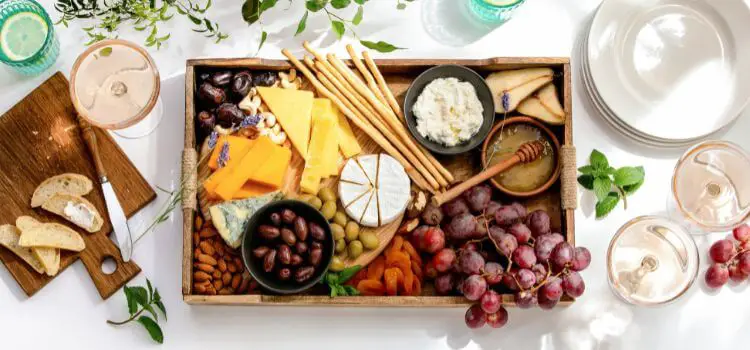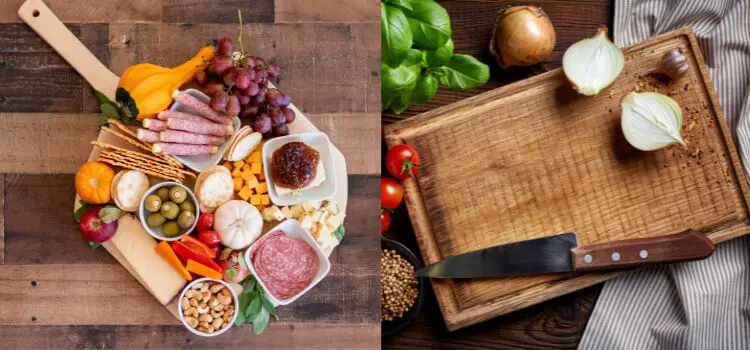As an Amazon Associate, I earn from qualifying purchases

In recent years, charcuterie boards have taken the culinary world by storm. Whether adorned with an assortment of cheeses, meats, fruits, or nuts, these boards have become a staple in modern food presentation, offering a visually appealing way to entertain guests. Their popularity has raised an intriguing question: Can a charcuterie board double as a cutting board?
While the idea of a dual-purpose board might seem convenient, it’s essential to explore the practicality and implications of using charcuterie boards for cutting tasks. This article aims to delve into the nuances between these two types of boards and provide a comprehensive guide on whether switching functions is a viable option.
Differences Between Charcuterie Boards and Cutting Boards
To understand the possibility of interchanging charcuterie boards with cutting boarads, we must first define their distinct purposes. Charcuterie boards are primarily designed for presentation and serving. These boards often feature a decorative finish and may be made from various materials like wood, slate, or marble, chosen for their aesthetic appeal.
In contrast, cutting boards are crafted with functionality in mind. Their primary role is to serve as a durable surface for food preparation, designed to withstand the rigors of chopping, slicing, and dicing. They are typically made from materials like bamboo, wood, or plastic, selected for their ability to endure heavy knife use without damaging the blade or the board.
The design and material differences between charcuterie and cutting boards are significant. Charcuterie boards may be more ornate, with intricate patterns or polished finishes, while cutting boards focus on being practical, often featuring grooves to catch juices or non-slip feet to prevent movement during use.
Pros and Cons of Using a Charcuterie Board for Cutting
Pros of Using a Charcuterie Board as a Cutting Board:
- Aesthetic Appeal: Charcuterie boards are visually attractive, adding elegance to your kitchen. Their decorative finishes can enhance the overall decor, making them ideal for those who prefer minimal kitchenware.
- Dual Functionality: A single board can serve multiple purposes, functioning both as a serving platter and a cutting surface. This versatility can save space and help reduce kitchen clutter.
Cons of Using a Charcuterie Board as a Cutting Board:
- Durability Issues: Charcuterie boards, particularly those made from softer or porous materials, may not hold up well under regular cutting. They are more prone to scratches and damage, which can affect their appearance over time.
- Hygiene Concerns: Boards designed mainly for serving may not withstand the rigorous cleaning required for cutting surfaces. This raises potential hygiene issues, especially when handling raw meats or fish, as proper sanitation is essential to prevent cross-contamination.
Material Considerations

The material of a charcuterie board plays a crucial role in determining its suitability for cutting. Common materials include wood, slate, and marble. Wooden charcuterie boards, especially those made from hardwoods like walnut or cherry, can offer some durability for cutting. However, they may still be susceptible to scratches and require regular maintenance to prevent staining or drying out.
Slate and marble boards, while striking in appearance, are generally not recommended for cutting. These materials can dull knives quickly and are prone to chipping or cracking under pressure. In comparison, cutting boards made from bamboo or plastic are designed to absorb the impact of knives, protecting both the blade and the board itself.
When evaluating the durability and suitability of charcuterie board materials for cutting, consider the frequency and intensity of use. Occasional, light cutting might not cause significant damage, but regular or heavy-duty chopping will likely compromise the board’s integrity.
Care and Maintenance Tips
If you decide to use a charcuterie board for cutting, proper care and maintenance are essential to prolong its life and ensure hygiene. Here are some tips:
- Cleaning: After each use, wash the board with warm, soapy water. Avoid soaking or using harsh chemicals, as these can damage the finish or cause warping. Rinse thoroughly and dry immediately with a clean towel.
- Protection: To minimize scratches, consider using a protective mat or cutting surface on top of the board when performing heavy-duty tasks. This approach can help preserve the board’s aesthetic appeal while still allowing for functional use.
- Maintenance: For wooden boards, regularly apply food-safe mineral oil or beeswax to maintain moisture and prevent cracking. This practice is particularly important if the board is frequently washed, as water can dry out the wood over time.
- Hygiene: Disinfect the board periodically with a mild solution of vinegar and water or a food-safe disinfectant. This step is crucial if the board comes into contact with raw foods.
Conclusion
In summary, while it is possible to use a charcuterie board as a cutting board, several factors must be considered to ensure it is a practical choice. The aesthetic appeal and versatility of charcuterie boards are undeniable, but the potential for damage and hygiene concerns cannot be overlooked. By understanding the differences in design, material, and intended use, you can make an informed decision that balances aesthetics, functionality, and practicality.
Ultimately, the choice may come down to personal preference and the specific needs of your kitchen. If you prioritize visual presentation and occasional use, a charcuterie board might serve you well in a dual role. However, for frequent or intensive cutting tasks, investing in a dedicated cutting board designed for durability and ease of cleaning may be the best option. Whatever you decide, ensuring proper care and maintenance will help extend the life of your board and keep your culinary creations safe and enjoyable.
FAQ
Can you use charcuterie boards for cutting?
Yes, you can use charcuterie boards for cutting, but be cautious. Charcuterie boards may get scratched or damaged due to their decorative finish. They also might not withstand rigorous cleaning, which is crucial for food safety. Consider using them for light cutting tasks and maintain them properly.
Can I use a cheese board as a chopping board?
You can use a cheese board as a chopping board, but it’s not ideal for heavy-duty cutting. Cheese boards are often designed for presentation and may not be durable enough for extensive chopping. They might also damage knives or become scratched, so consider using them for lighter tasks.
What wood should not be used for cutting boards?
Softwoods like pine and cedar should generally be avoided for cutting boards as they are prone to scratches and dents, compromising durability. They can also harbor bacteria due to their porous nature. Hardwoods like maple or walnut are preferable for their sturdiness and resistance to moisture.
What can you use instead of a cutting board?
In a pinch, you can use a sturdy plate, a clean countertop, or a baking sheet as a temporary cutting surface. However, these alternatives might damage knives or surfaces, so it’s best to use a proper cutting board when possible to ensure safety and preserve kitchen tools.
As an Amazon Associate, I earn from qualifying purchases